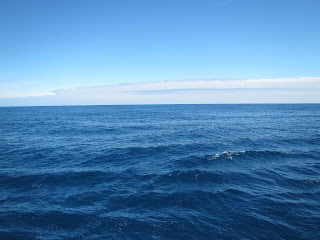We're currently approaching Nassau, where we'll be alongside for a few hours, just long enough to clear customs, calibrate a gravimeter, and trade Gerard for me. Since this is the end of the trip for me, I've been reflecting on the cruise, and how it's similar or different to the Antarctic voyages I've spent more time on recently. The obvious difference, of course, is the temperature, and I've certainly enjoyed the opportunity to take a tea break outside without huddling over the mug for warmth, and to go for a dip in the "pool" on deck.
The "pool" is a deep plastic tub just large enough for one person, temporarily repurposed from its day job as a place to keep instruments immersed on their way onto or off of a mooring. When it's brilliantly sunny, warm and humid out, though, it's as refreshing as . . . well, not as refreshing as a dip in the sea, but probably just as much as any luxury pool on the big cruise ships we can see making for Nassau.
Other than trading layers of fleece for more sun cream, the daily routine is not too different from a subpolar to a subtropical cruise. The difference with the most effect is not so much the temperature as it is the consistency of the weather. With calm seas being the norm rather than a transitory event, you can almost forget you're at sea, and get accustomed to things staying where they are placed. There are non-skid mats at the tables, and some of the excess chairs are tied down, it's true, while of course instruments and equipment are well secured; but for weeks at a time, small things like notebooks and mugs are simply left on desks overnight, and are still there in the morning, rather than on the floor at the other side of the lab.
Over the last few days everyone got the opportunity to use their securing skills again, as the weather went from a bit rainy to downright stormy. Forty-knot winds and the accompanying seas stopped most of our work, since the ship's motion would make it too dangerous to do a CTD cast or deploy or recover a mooring. The bad weather seemed to be centred over our next planned mooring site, WB6, and was forecast to sit there for a few days, so we decided to head in to Nassau a bit early, leaving time to return to WB6 in better conditions. We deployed the last two Deep Argo floats on the way, in whipping wind and spray that almost made me feel like I was back in the Southern Ocean, not the balmy subtropics. Almost, but not quite!
 |
| Subtropical Atlantic two days ago or Southern Ocean on Yvonne's last expedition - can you tell which is which? |
-----------------------------------
I've had an interesting and thoroughly enjoyable cruise with a great group of people, and I'm a bit wistful to be leaving before the western boundary segment, but I'll be wishing everyone good weather, and good data return!












